People come year-round from all over the world to soak up the sun in the Yucatan Peninsula of Mexico. Besides the turquoise waters, warm inviting climate, and Mexican food, what drew my boyfriend and I to this country was the history of one of the world’s oldest known civilizations, the Mayans. Ancient sites have been uncovered and carefully preserved for travelers seeking a greater understanding of the Mayans, including one of the seven wonders of the world. A few small historical sites are located within urban areas but the major ones require traveling a good distance into the jungles of Mexico.
Wheelchair Tour
For decades these world treasures have been nearly unattainable to reach for wheelchair travelers, but a company called Cancun Accesible does all it can to make touring Mexico possible. Cancun Accesible has three wheelchair accessible vans that can transport six wheelchair users and nine companions at the same time. The height of the vans inside is spacious to provide ample head space and there are tie-downs for wheelchairs and seatbelts. The vans have not been lowered so the ramps into the vehicles are steep, but the driver is always able to assist with a push.
Chichen Itza
On day one we headed to Chichen Itza, the ruins of one of the largest Mayan settlements, one of the Seven Wonders of the World, and my primary reason for coming to Mexico. Cancun Accessible set up an excellent tour of the excavated structures that highlighted how much is still covered by the jungle and how much we do not know.
The highlight of Chichen Itza is the iconic pyramid called El Castillo, used for many Mayan cultural and religious purposes. Today, all the major archeological sites do not permit people on them to preserve them, so everyone gets the same ground-floor view. At Chichen Itza wheelchair users are on the level, as no one is allowed on the stairs! The Mayans possessed a depth of knowledge about the cosmic universe without modern-day telescopes and technology. Spring and fall equinoxes draw the most tourists, many of whom come to marvel at the astrological ingenuity of El Castillo and many of the other surrounding structures. A guided tour showing the many details and explaining the history is highly recommended.
The generally flat landscape at Chichen Itza made getting around doable for manual wheelchairs and no problem for those with power, but there are some areas of caution. Designated parking is offered and the entrance fee is determined by one’s physical mobility. In our case, since we use manual wheelchairs we got in free because parts of the pathways present some challenges. The majority of the area was very firm and easy to navigate. Local vendors selling hand-carved arts and crafts are everywhere.
Across from the ticket office at Chichen Itza is the beautiful Posada Hotel. The area around this hotel is paved and the hotel itself is a good place to eat while visiting Chichen Itza. Ramps allow you to move through the hotel to the buffet dining area where you can sample Mayan, Mexican, and international foods. The taco stand with fresh, handmade tortillas was our favorite; the hotel staff is all around to assist in carrying your plate if needed. The dining room has an enormous patio for seating and a partially enclosed space with beautiful stained-glass windows where you can watch frequent dance performances.
Tulum
Like Chichen Itza, the price of admission was based on a person’s physical mobility, so we once again got in for free. I found this reasonable considering that the hilly and sandy terrain of Tulum poses challenges for some wheelchair users. The information center by the parking lot has a special wide-tired wheelchair you can rent for free.
From the parking lot, it is a good 10-20 minute stroll to the archeological site. Along the way, you will pass a few tourist shops and restaurants. During heavy rain the street to the site can flood, forcing pedestrians to the outer banks, which have enough access until you reach the two two-foot bridges; we had to be carried over. After a couple of patches of cobblestones, a few small and two large ramps, and through the short, uneven tunnel pathway Tulum is all around. The pathways are packed dirt with small rocks and sand, which can become firm enough to travel across reasonably in a wheelchair, but avoiding thick sand entirely isn’t realistic and at times traveling across the grass is easier. Fortunately, when I got stuck, Cancun Accessible was right there to help. Only a few areas and pathways can be accessed by a wheelchair overall due to deep sand barriers; one, in particular, takes you to a small beach cove below the Castillo and another directly in front of it. Tulum is still worth visiting to explore the details of some of the standing structures and with power/barrier assistance it is a lot easier for manual wheelchairs.
Swimming with Dolphins
After Tulum we made our way to a resort to swim with the dolphins; it was called El Dorado Maroma (adults only) and about 1 hour away from Tulum. In Mexico, there are a plethora of companies offering the opportunity to swim with dolphins. However, according to Cancun Accesible, Dolphin Discovery has the best overall experience and treatment of their animals, including an enclosed habitat in the actual ocean.
Getting to the saltwater pool from the parking lot was easy using the very smooth paved asphalt pathways. Ramps were also not too steep, besides the one up to the pool deck. Dolphin Discovery is equipped with a beach wheelchair that takes you from the pool deck down a ramp into the pool. Life jackets are put on every visitor and Dolphin Discovery provides a person in the pool with you for extra assistance. Three different packages are offered, depending on how much interaction you want and what’s physically possible. We got to touch and kiss the dolphins a lot, but just being in the water with them brought an incredible feeling of joy.
One inaccessible lowlight was that the changing rooms and the bathrooms were not wheelchair accessible. We secretly changed into our swimsuits at a cabana next to the pool deck, which was not accessible (1 step) and not entirely closed off. We got back into our clothes in the men’s main locker room area while our driver stopped anyone from coming in; the main entrance had no door. The women’s locker room was way too revealing for people passing by. We made it work but it is a detail to be aware of.
Beach Activities
After the dolphin swim we made a quick visit to the nearby beach, Playa del Carmen. There are thousands of miles of beaches in Mexico. It’s probably the top reason people travel here, so what about wheelchair users? Playa del Carmen, which is in between Tulum and Dolphin Discovery, is a great place to start. Colorful 5th Street is where most of the shops and restaurants are located and is worth visiting. Some restaurants have some kind of access but, as seen throughout Mexico, most shops have one step. A small hill leads down to the ocean with ladies selling fresh fruit and other topical items; a good push-up for manual wheelchairs.
Just beyond the sand, you can find the Portal Maya (The Mayan Gateway), a famous sculpture designed by Jose Tavares. You can’t miss it. It towers into the sky and is the site of regularly scheduled traditional dances, with ceremonial dress and music. The sculpture marks the entrance to Playa Fundadores and there’s another beach nearby called Playa Punta Esmeralda. Playa Fundadores had accessible bathrooms and showers and fifteen to twenty beach wheelchairs you can rent for free, thanks to a government accessibility program.
At one of these accessible beaches, we met Inez Gonzales Gonzalez, a power chair user who recently moved to Playa del Carmen from Spain about four months ago. She had recently gone scuba diving with whale sharks, and told us about a company in Playa del Carmen, called I Love to Make Bubbles Underwater that assists people in wheelchairs with scuba diving. Playa Fundadores in Playa del Carmen is also close to the dock where a ferry takes visitors to Cozumel. Lifewaters.org, a U.S.-based non-profit that trains people with disabilities to scuba dive, offers extensive packages there. Cozumel has an airport along with places to stay, eat, sleep, and enjoy.
Besides Playa del Carmen, the other accessible beach in the area is Playa Delfines by the Hotel Zona and the airport. It takes a while to repair inclusive beaches from storms since they are all maintained by the government. Much repair is needed to the pathway to get out onto Playa Delfines; it’s been more than two years [since a storm destroyed access] and still nothing. The wooden-planked pathway starts at the parking lot with several designated spaces and leads to a set of cabanas specifically designated for those with limited mobility, but currently are free-for-all. A few bathrooms are accessible along the .25-mile paved promenade and are often locked, but a guest service employee is at one of the regular bathrooms who can unlock it. These were the most spacious bathrooms I saw in Mexico, big enough for any chair, and spacious for changing in and out of a swimsuit.
In the Hotel Zona of Cancun, and many other areas of Mexico, you can rent jet skis and parasail off the back of a boat. There are no modifications made but for some these activities may be possible. Fashion Harbor Mall in the Hotel Zona rents boats and less accessible water options.
Another option is to explore one of the area’s many resort parks, offering everything from snorkeling to zip lines to inner tubes and much more – all to soak up the sandy white beaches and crystal clear water. The most accessible options are Xel-Ha and Xcaret. The two are about an hour and a half away from each other. Of the two Xcaret has more options with access. Like the archeological sites, these parks also discount tickets based on a person’s physical mobility—determined only in person to prevent fraud. Even if an attraction is semi-accessible, ask for a discount. We did it at the aquarium on Fashion Harbor in Cancun and got 50 percent off even though it was pretty much entirely accessible.
Cenotes (Water Wells or Sink Holes)
Our tour guide told us there are 14,000 known cenotes in the Yucatan Peninsula area but more certainly exist. They are formed by underground rivers and some are considered to be sacred spaces, while others are used as town drains during rainfall. Most cenotes are inaccessible for wheelchair travelers, but some can be viewed from the surface like Ik Kil — perhaps the most famous one in Mexico — located by Chichen Itza.
An incredible way to experience a cenote and the underground rivers is at the Rio Secreto, a tour of cenotes and underground waterways just west of Xcaret. After a fifteen-minute drive deep into the jungle to the entrance of the cave, a guide performs a five-minute ritual to ask the universe permission to enter. Everyone then strolls for about ten more minutes to reach the cave’s paved ramp. About fifteen minutes are spent exploring the cave’s stalactites and stalagmites with the guide, followed by a short movie.
Boat Ride + Cultural Dinner
For the first time, Cancun Accessible decided to include a unique dinner on a boat through the jungle with a company called Xoximilco. The night consists of lots of eating and drinking with live music, starting at the reception area before boarding the boats. This area is smoothly paved with a large accessible bathroom. A side ramp allows wheelchair guests to get to the boat dock. Everyone else on the boat gets on first then the crewmen stand at the front end or bow to make it level with the dock to just roll right on. Chairs were removed upon request to remain in the wheelchair. The slope to the dinner table was short and required a bit of finessed skills.
Every boat has a guide to explain things but also encourages people to party. The whole experience is about three hours long. Once on the boat the meal showcasing traditional Mexican food begins. Tequila is offered along with beer, soft drinks, and water—all you can drink. As the boat flows on along with other party boats, stops are made at parked boats for food service and entertainment. The dark river and surrounding jungle make every turn a mystery. Cactus, different meats and treats were all sampled and served directly to us without leaving the table. Once we got our next course the following stop would be at a boat with a live band playing Mexican music. At the halfway point guests can get out, drink more alcohol, check out the gift shop, or use the restroom; one of which was modified for wheelchair access. The remaining ride continues with more music over dessert and coffee. It was an impressive production, like a Disneyland ride of a Mexican dinner and show.
Shaman Visit
My first full day in Mexico was a day I’ll never forget. We left our hotel while watching a glorious sunrise, for a date with a shaman at the Jardines del Colibri Dorado in Sisbicchén, Yucatan. Translated literally, Jardines del Colibri Dorado is the Gardens of the Golden Hummingbird. It is a beautiful ranch that is impossible to find unless you know where you are going. We had no idea what to expect and neither did the tour company; it was a new exploration for all of us and the first time someone requested to see a Shaman. We were greeted by a few friendly dogs and four healers, including the shaman known as Abuelo Antonio. We connected immediately. Following Abuelo Antonio into the barrier-free meditation room, we talked while drinking water from a sacred cenote over Santa Maria before the main part of the ceremony.
Once it was time, we lay on a massage table and received our treatment. Specific candles were lit next to burning incense. The shaman explained that incense grounds us and nourishes the earth (ashes) and the smell (smoke) is a gift for the heavens. Different oils were rubbed onto our skin and prayers were whispered as a special kind of acupuncture was performed. Each session was customized and sometimes all four healers were working simultaneously on me. At one point the skylight painted rainbows on our skin. After the treatment we remained on the tables for a good while in a deep meditation, feeling the vibrational frequencies flow. I snapped out of it upon hearing the Shaman quietly tell our driver and guide that we were almost finished. When I was finally able to move I felt as light as air and embraced the Shaman with a long, loving hug.
Additional Info
Hotels
Upon arrival at the Cancun airport in early November Cancun Accesible was waiting for curbside with a warm greeting. The sun was shining brightly but we knew we had some rain showers in store for us. I selected the Westin Lagunamar Hotel on a narrow strip of sand known as the “Hotel Zona,” where you will find hotel after hotel mixed with shopping areas and restaurants. The Mayan Museum and Cancun Aquarium are also located on this strip. Many curb ramps have been installed in this tourist area but some sections have been missed and many entrances were not accessible, so plan cruising accordingly.
What is currently known as Cancun began in the 1970s as a government-funded project to lure tourists to the area. In 2005 Hurricane Wilma destroyed nearly all of the hotels, many of which have been successfully rebuilt. The Westin Lagunamar is one of the rebuilt hotels and is the only one along the beach that is equipped with a pool lift. However, this is only one pool and the Jacuzzis have nothing. A ramp at the other pool provides a barrier-free entrance. Disappointingly, there was no balcony access in any of the rooms and no beach access.
About a 15-20 minute drive away from the Hotel Zona in downtown Cancun holds the Four Points Sheraton Hotel — the only other hotel with a pool lift. In addition to the Westin Lagunamar, the other hotels that have barrier-free entrances into the pool are the Secrets Playa Mujeres Golf & Spa Resort, the Occidental Grand Xcaret Resort, and the Grand Bahia Principe.
General Access: Eating, Bathroom, Ramps + Getting Around
Accessibility in Mexico is not perfect, but where is it? Access to bathrooms is the biggest infrastructure improvement needed. In developed areas, you don’t need to go that far to find an accessible bathroom, but the more rural parts have less knowledge about wheelchair access needs. American chain restaurants couldn’t even be relied on to always be accessible.
Commonly shops have a step or two inside, even in the nicest shopping areas in Cancun and Playa del Mar. More restaurants than shops seemed to have ramp access. However, a number of nice restaurants did a poor job of creating access or nothing at all. Some ramps were fantastic, some were steep, and some were homemade but doable, especially if you are like me and will just grab a nearby stranger to help. Access to sidewalks may end abruptly due to a barrier or lack of a curb cut. Sometimes riding in the street is the best way, but do so at your own risk. Designated parking spaces for wheelchairs exist but do not have the crosshatch space to get in and out.

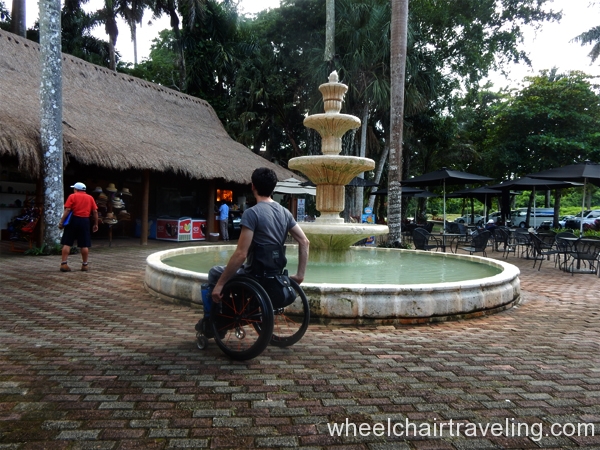
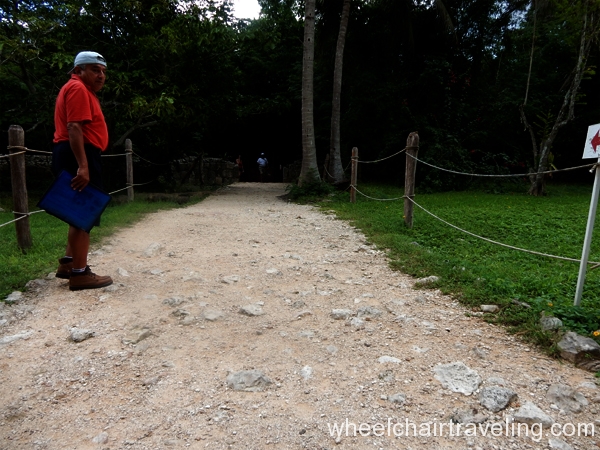
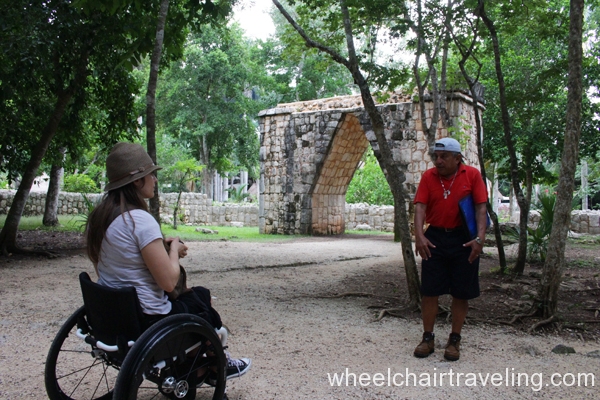
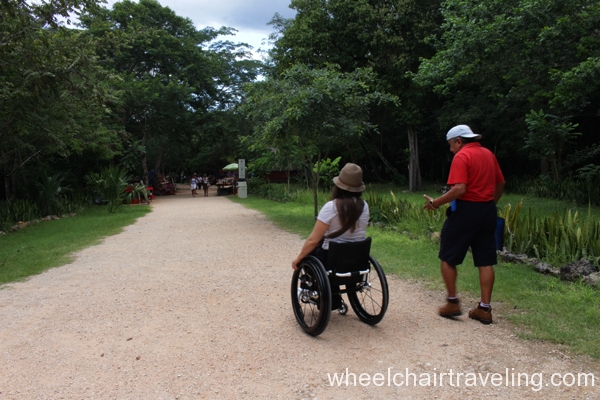
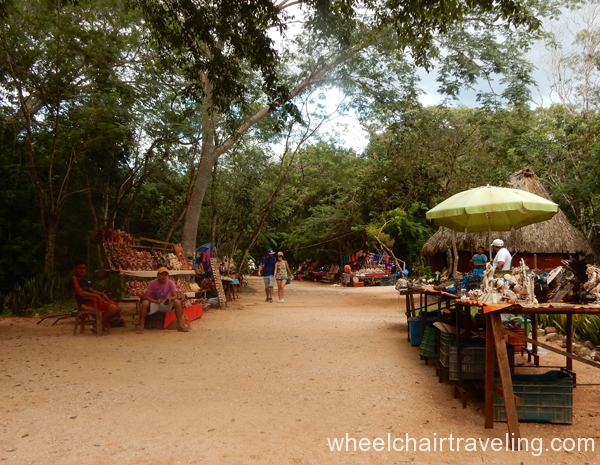
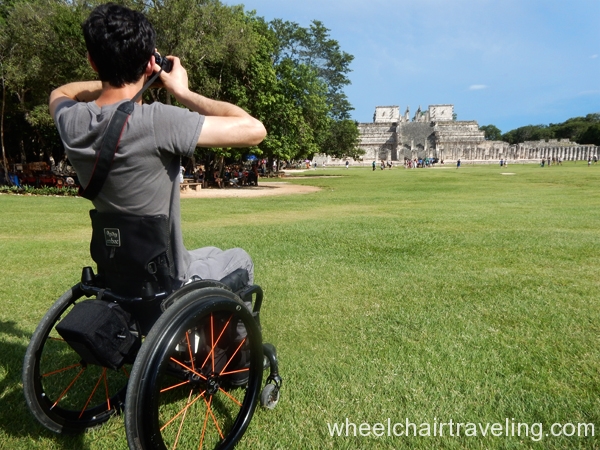
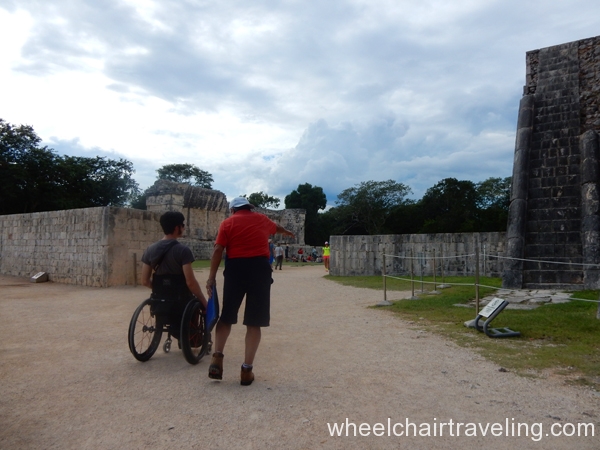
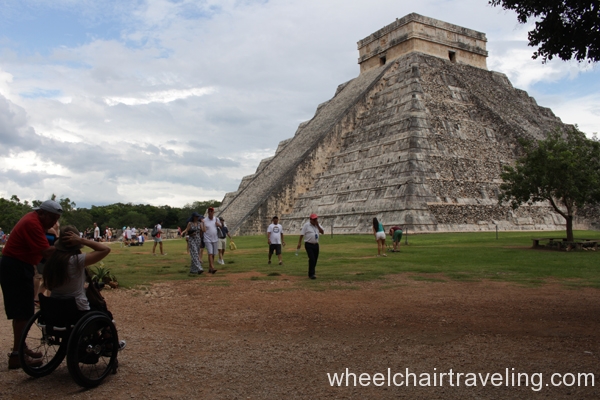
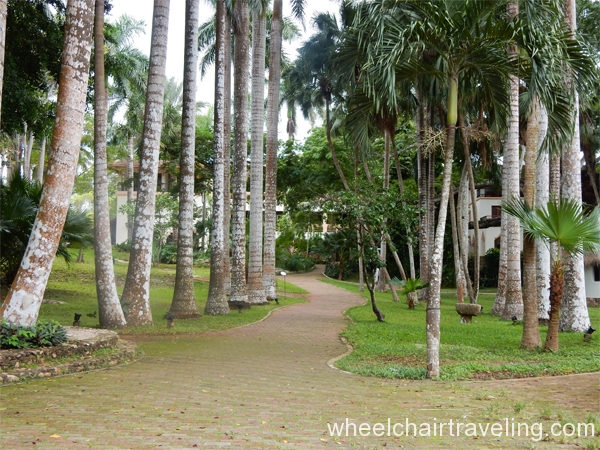
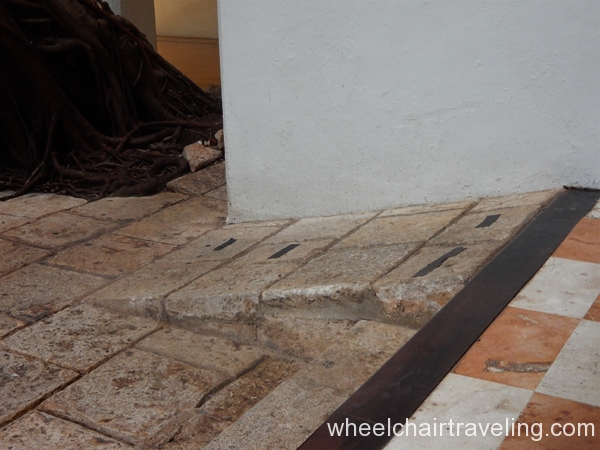
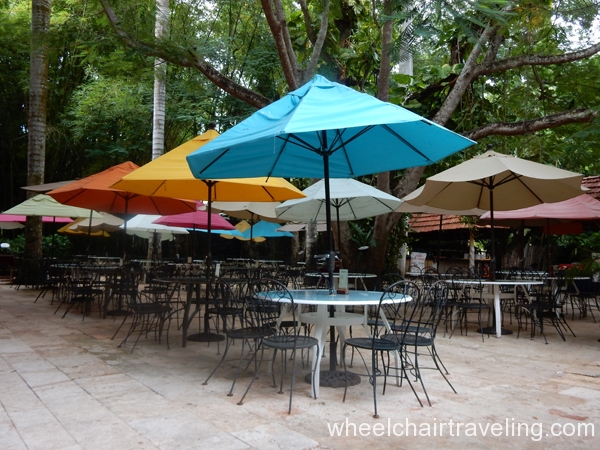
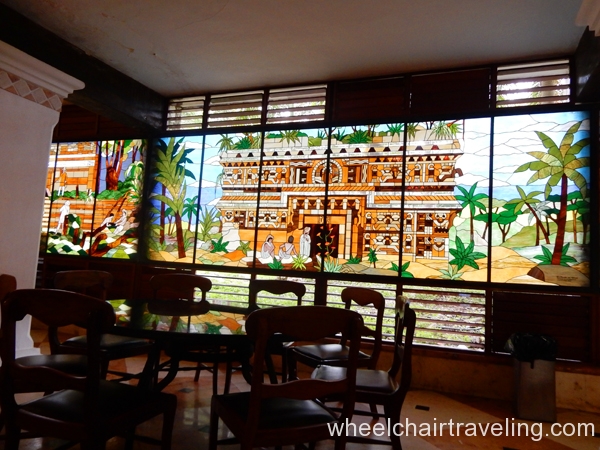
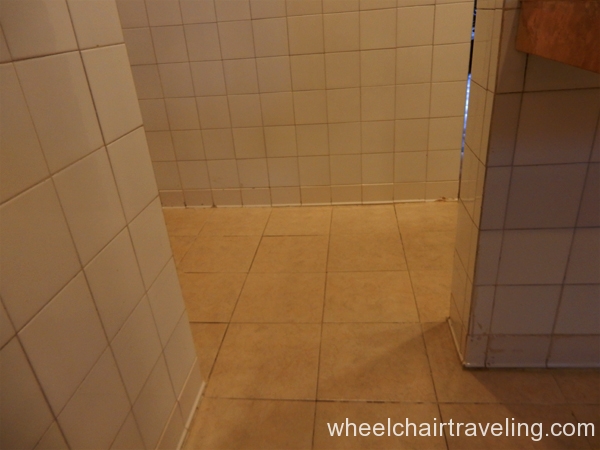
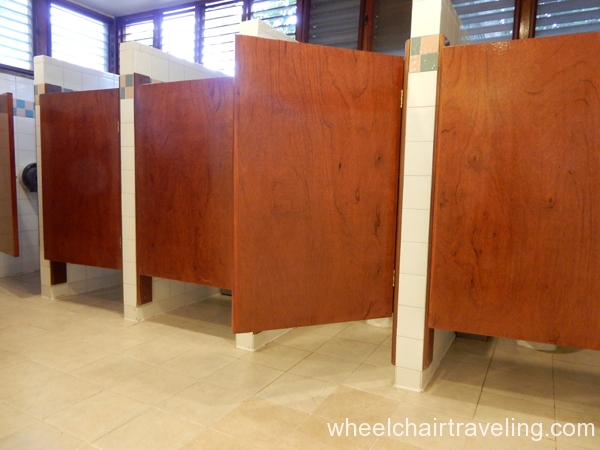
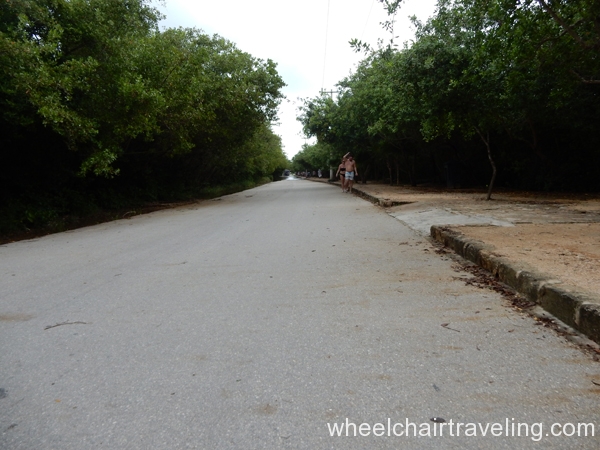
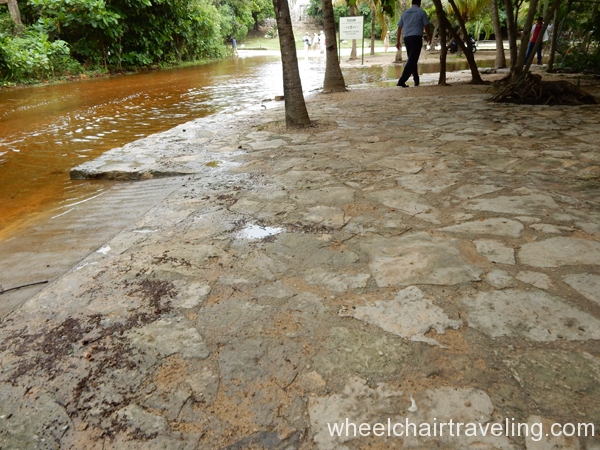
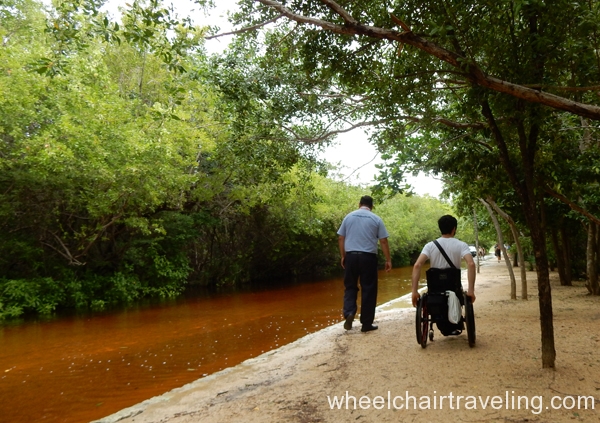
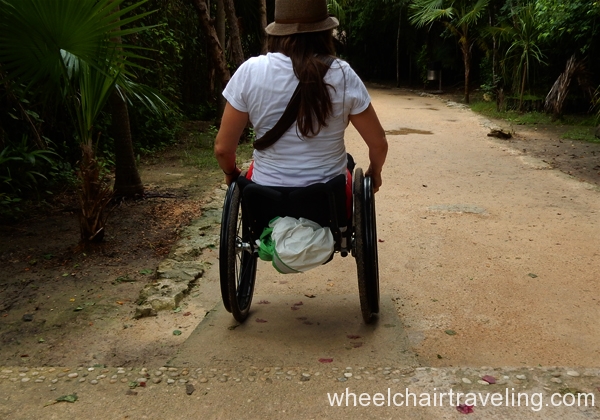
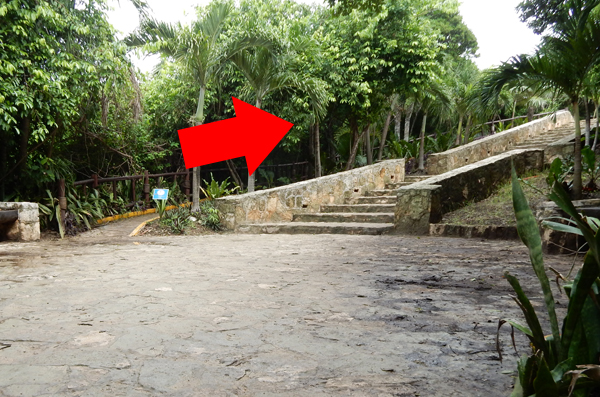
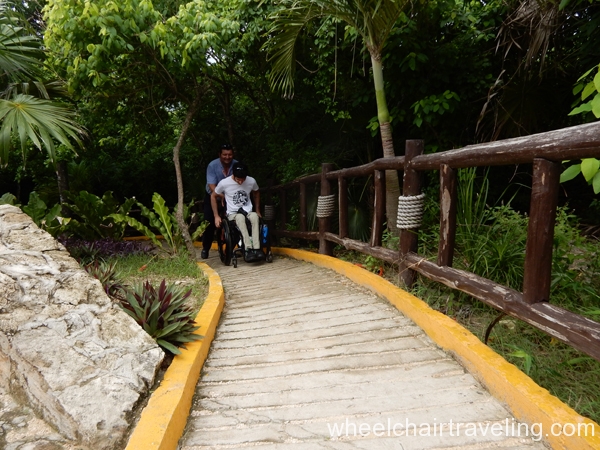
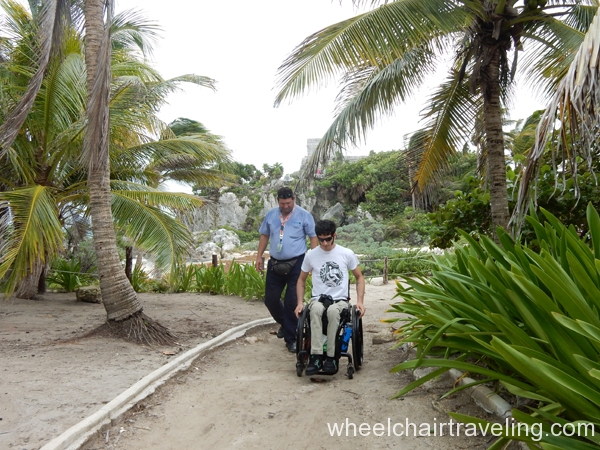
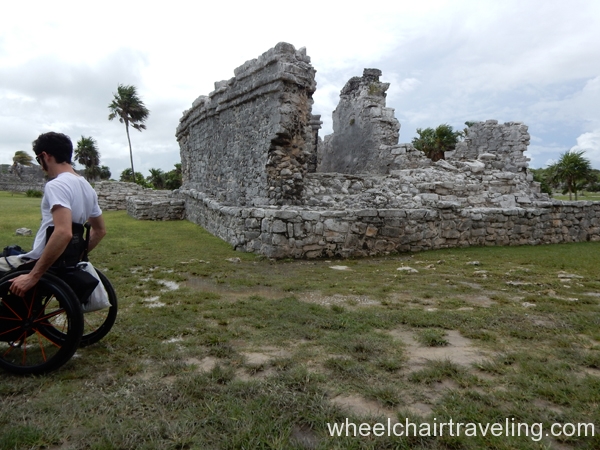
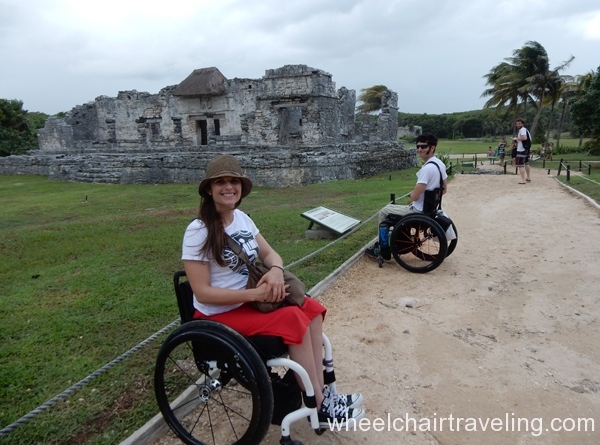
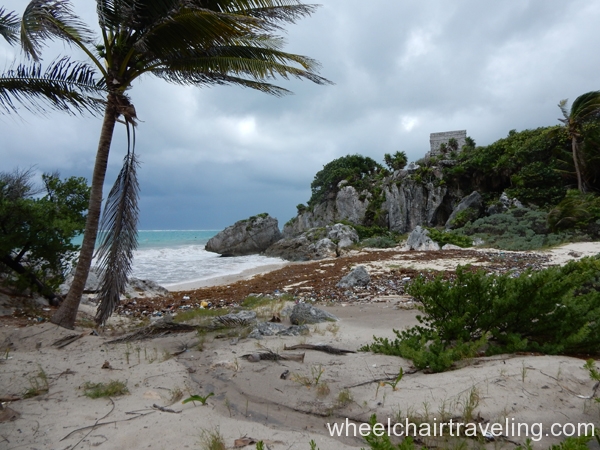
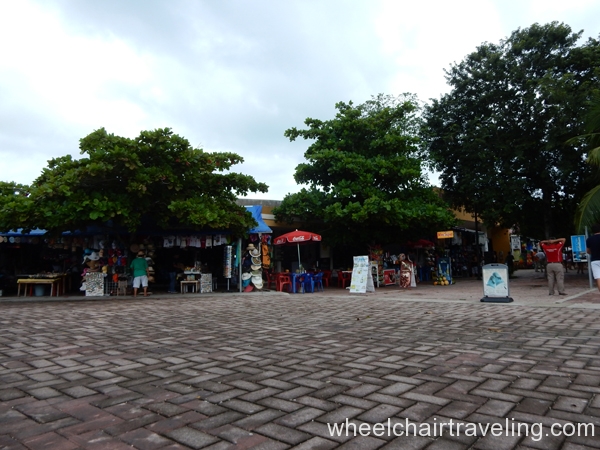
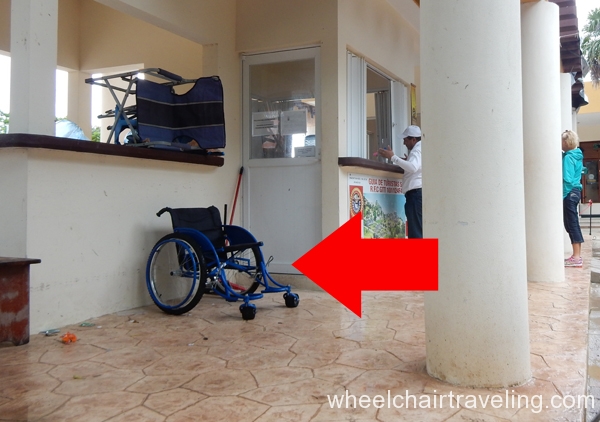
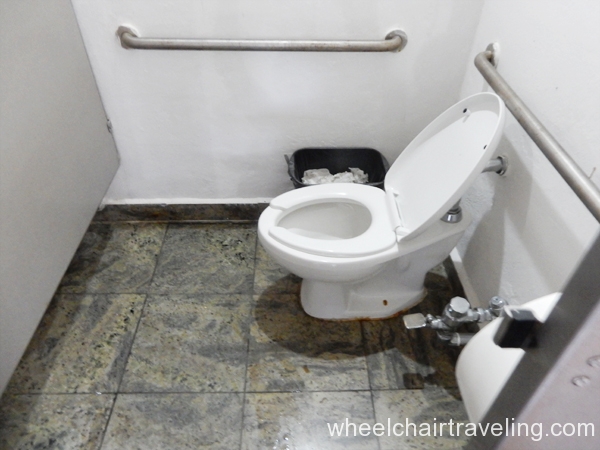
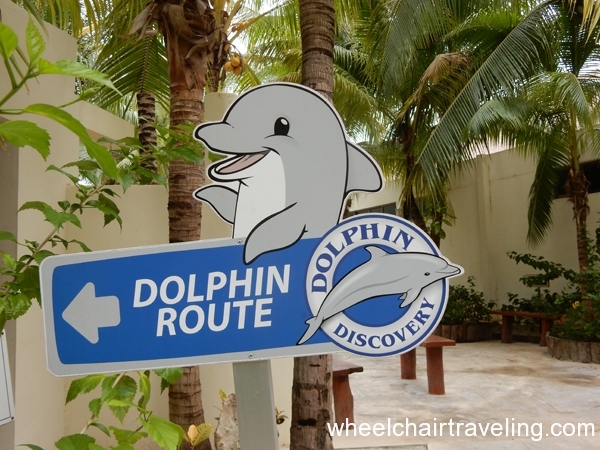
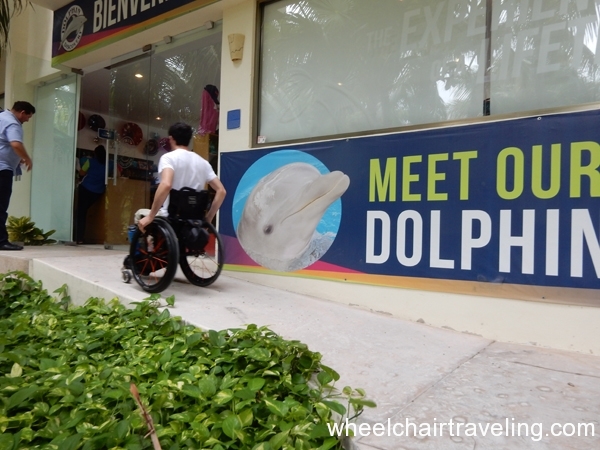
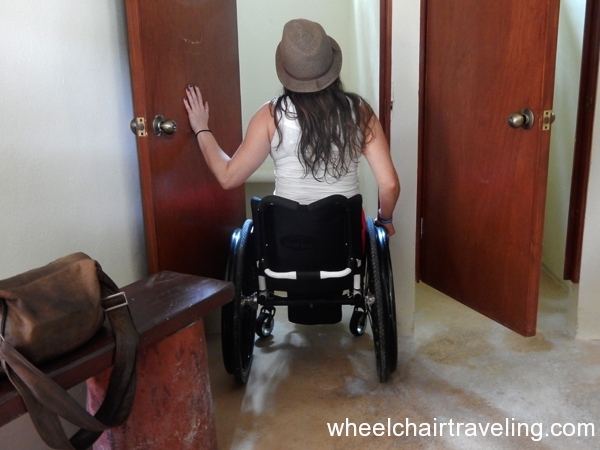
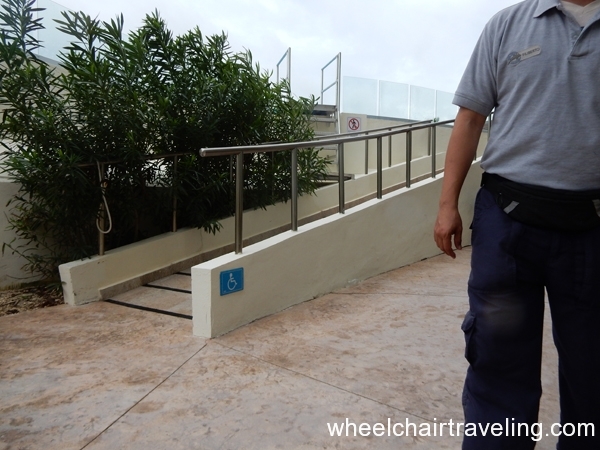
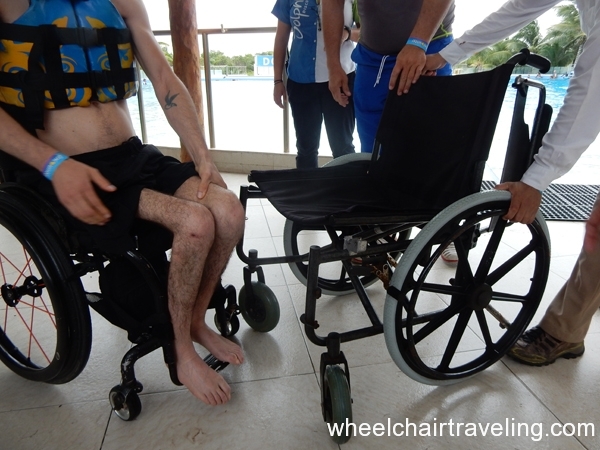
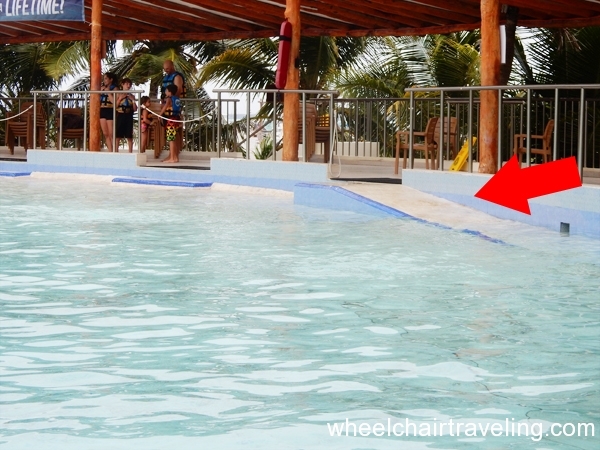
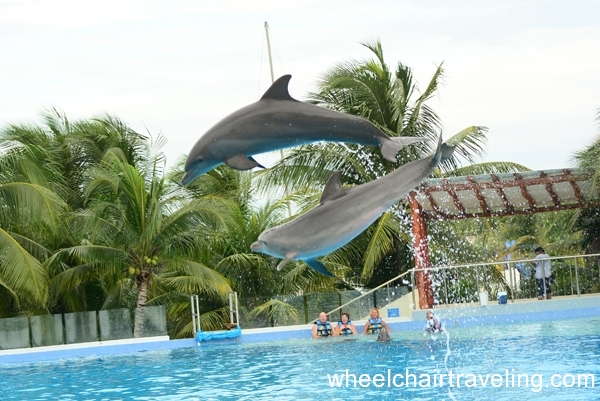
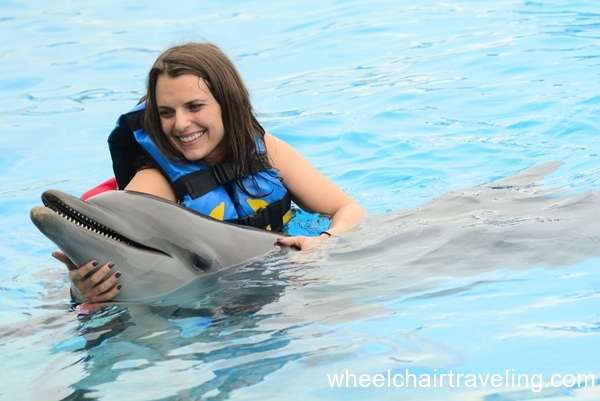
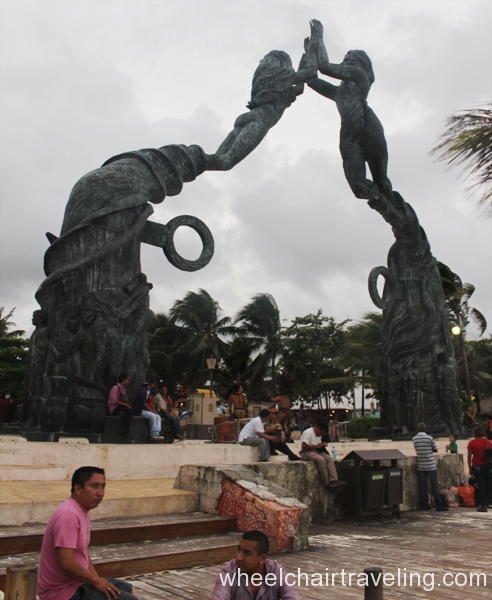
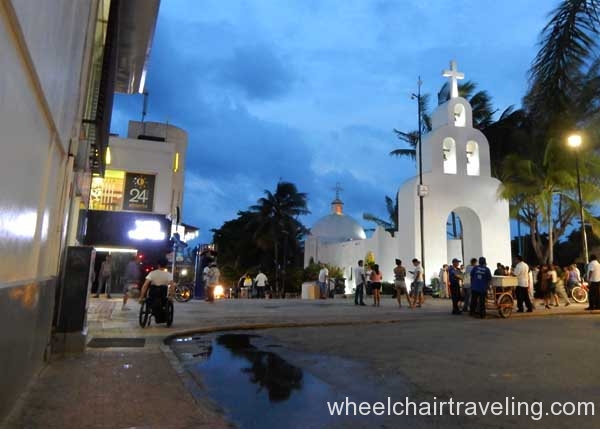
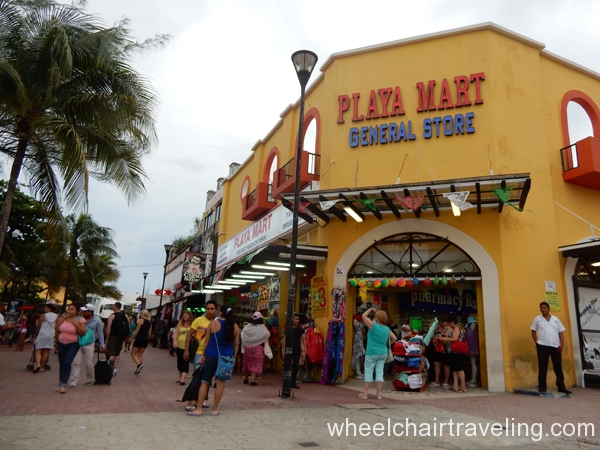
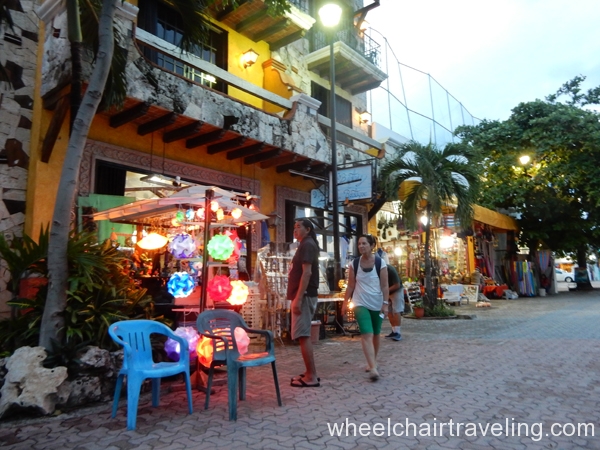
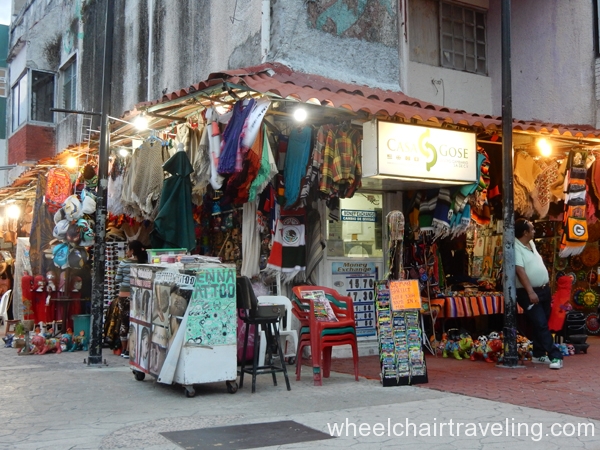
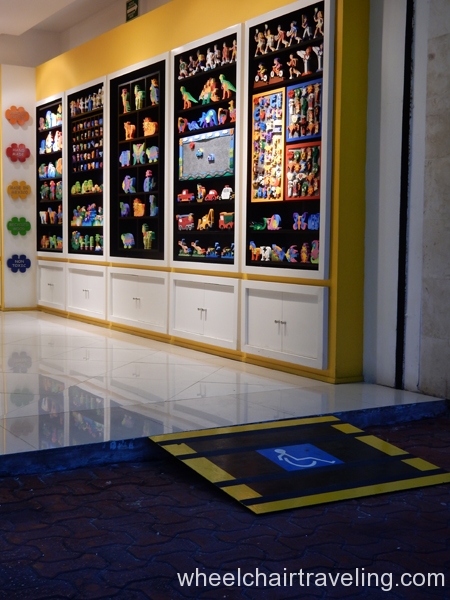
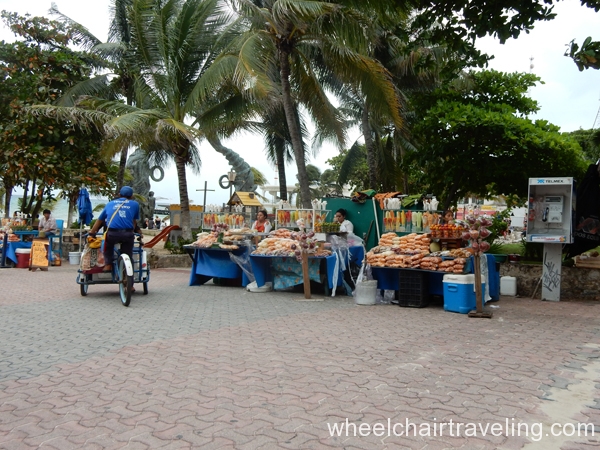
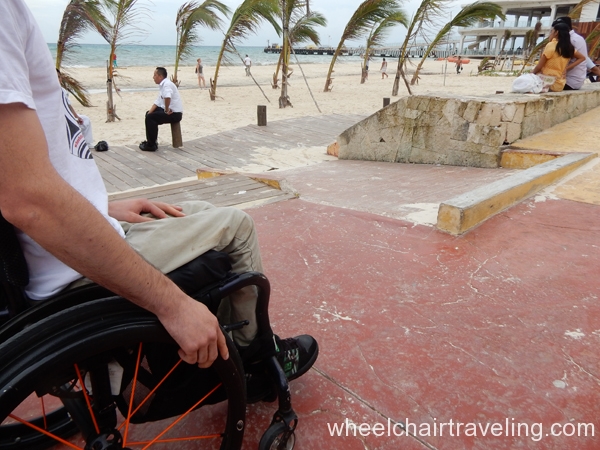
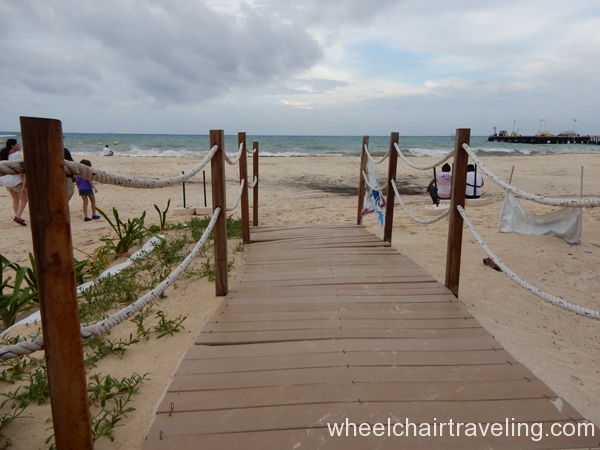
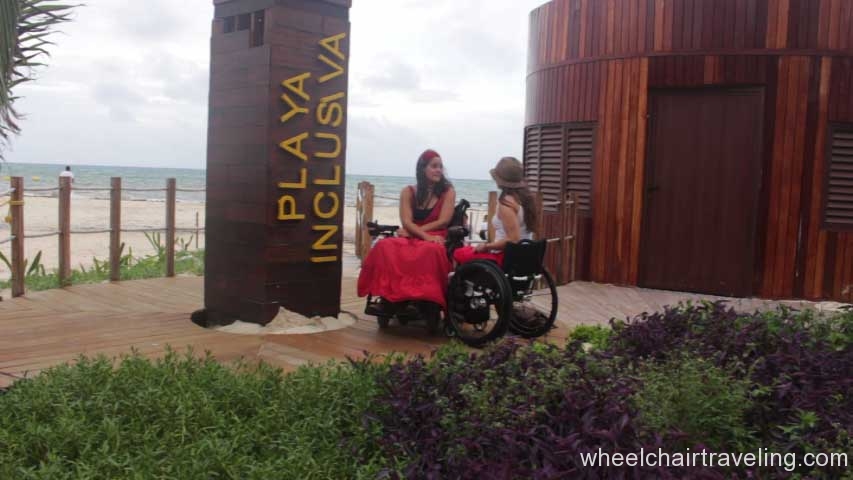
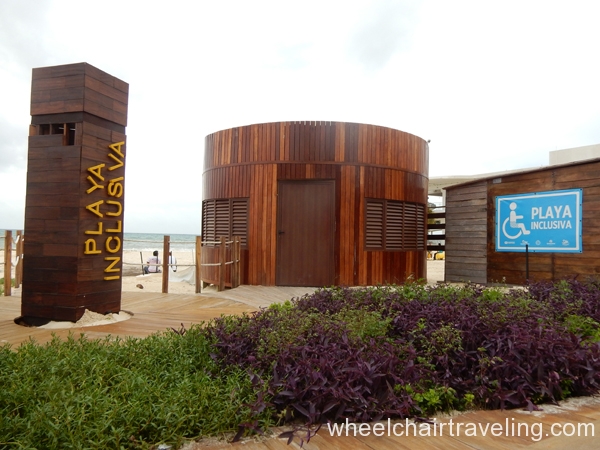
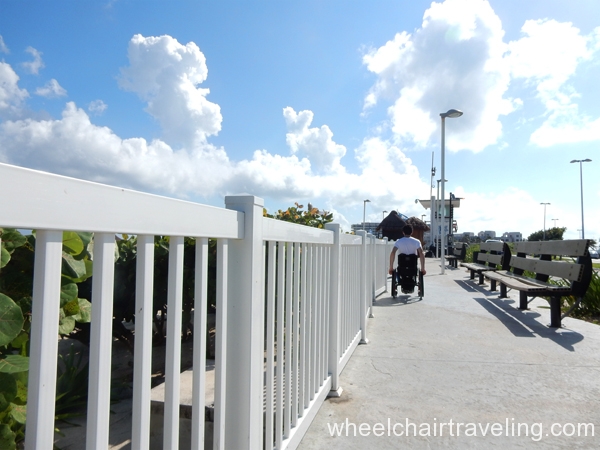
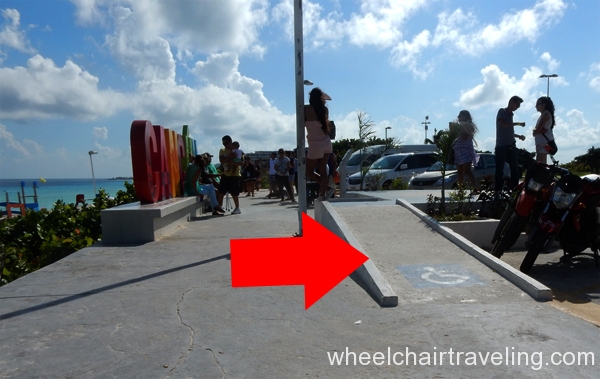
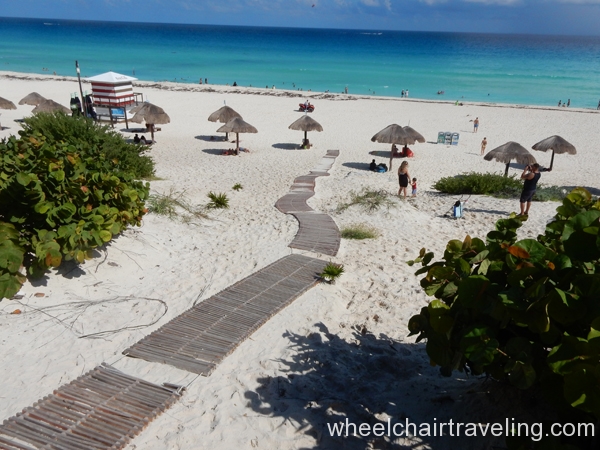
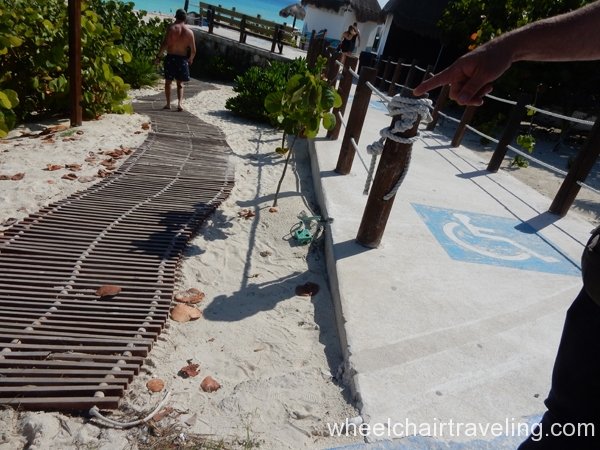
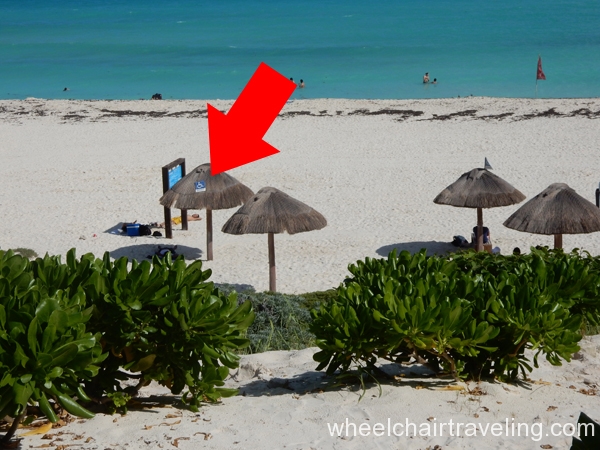
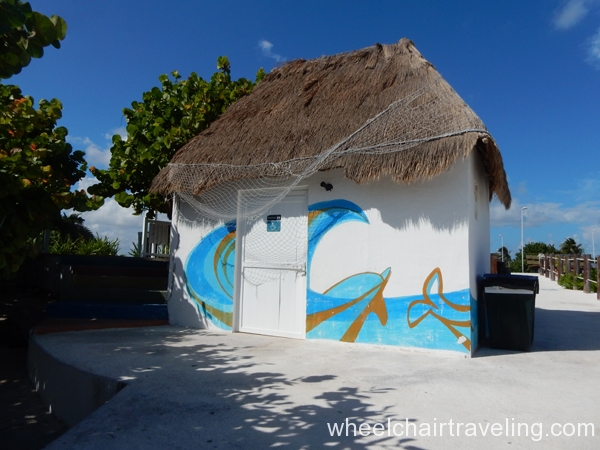
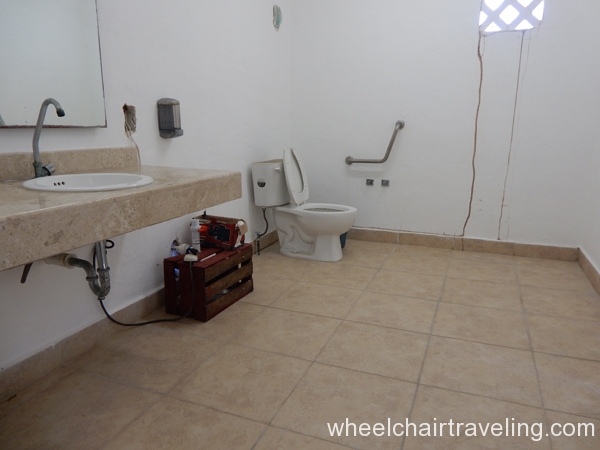
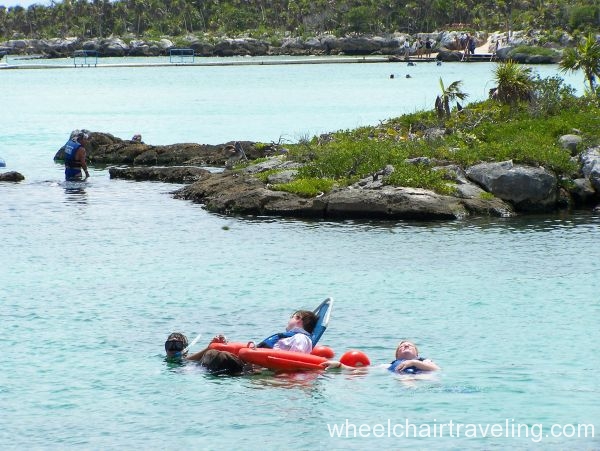
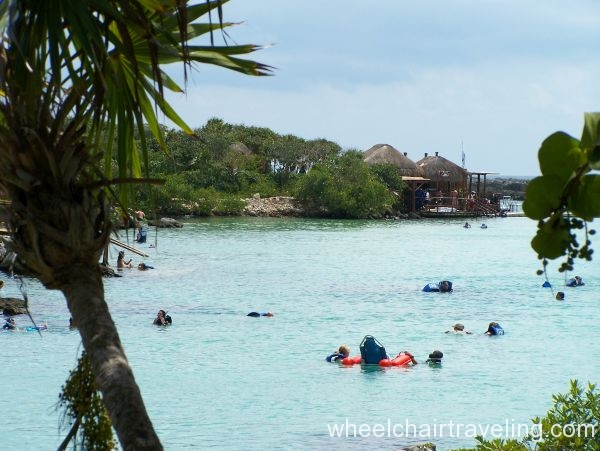
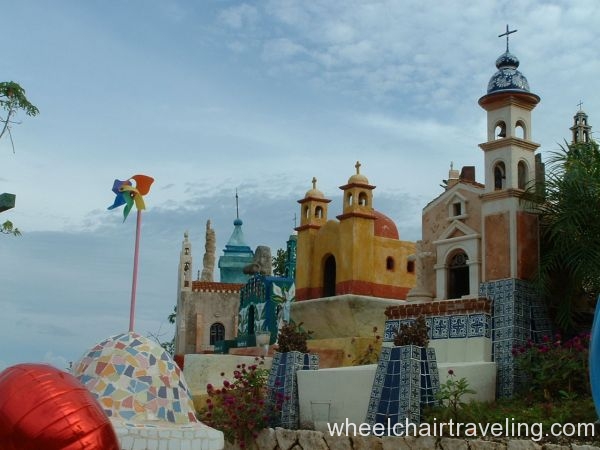
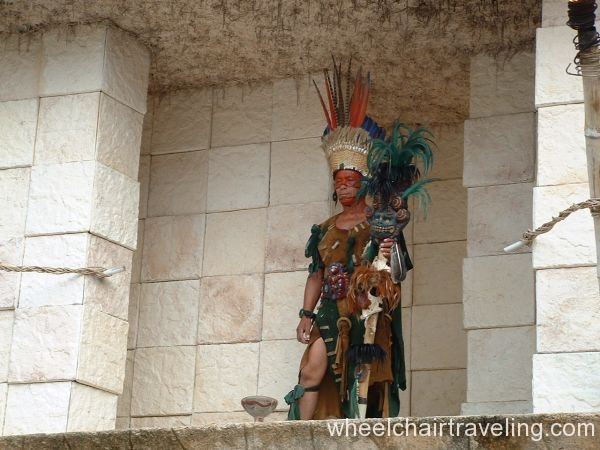
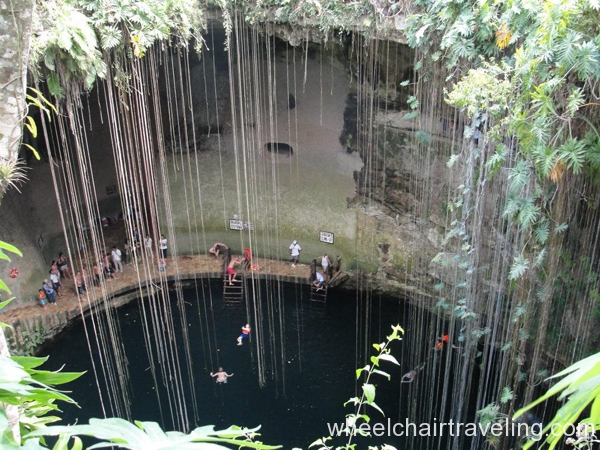
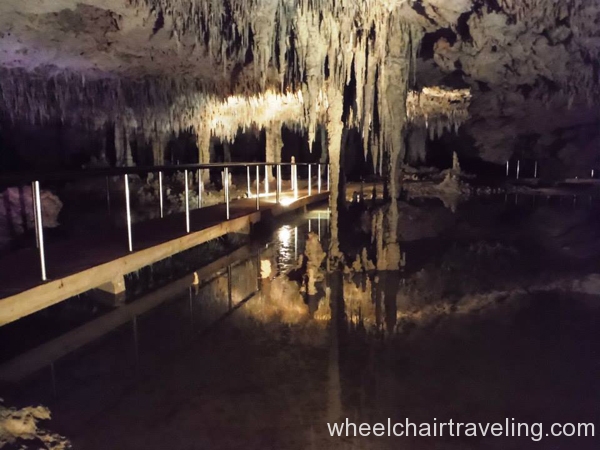
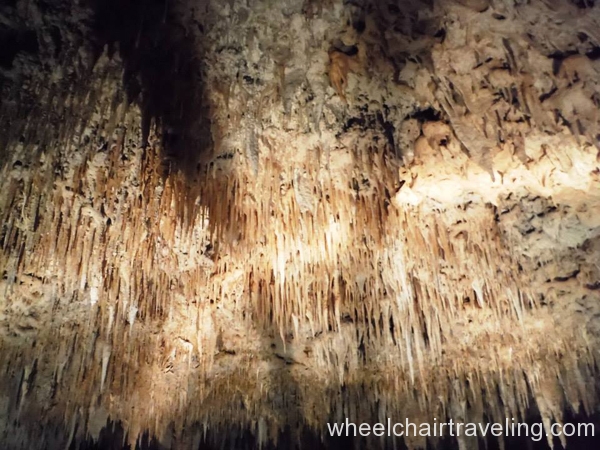
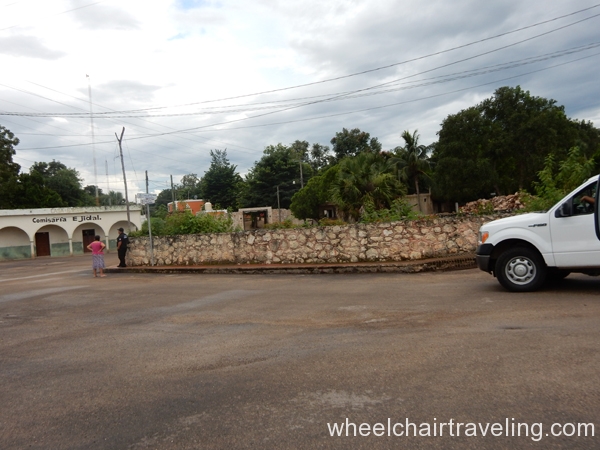
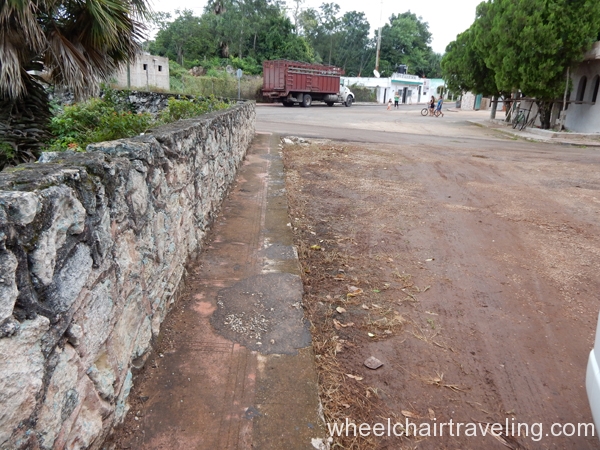
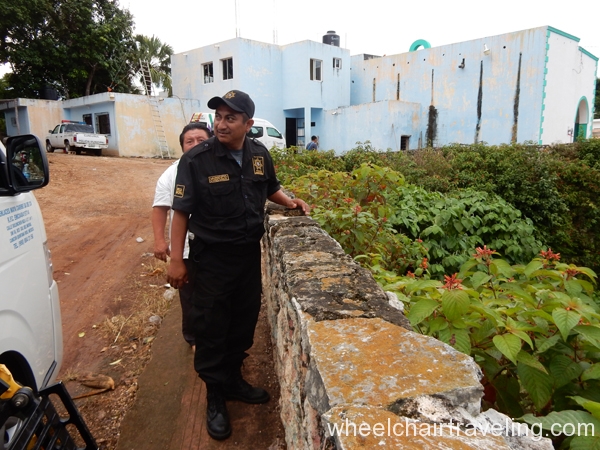
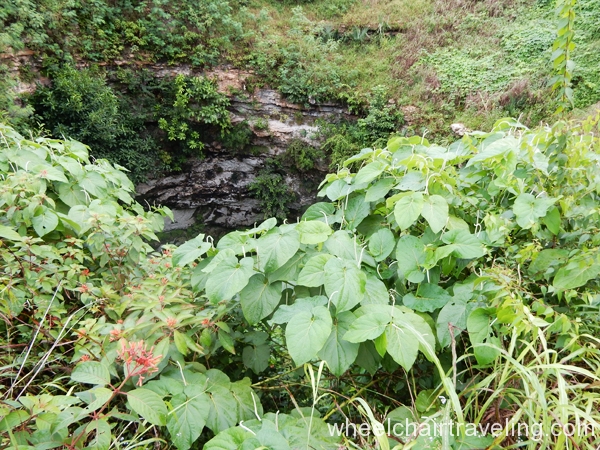
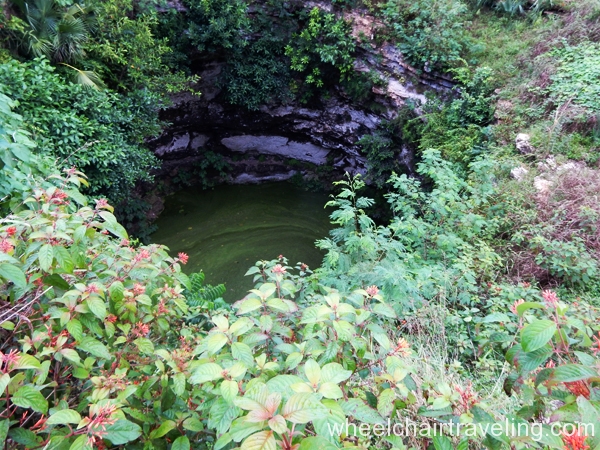
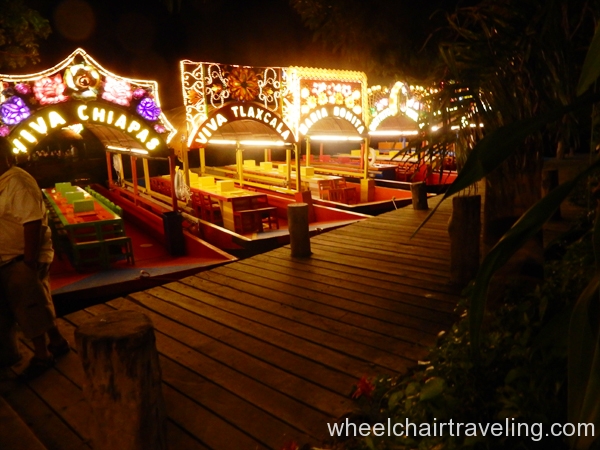
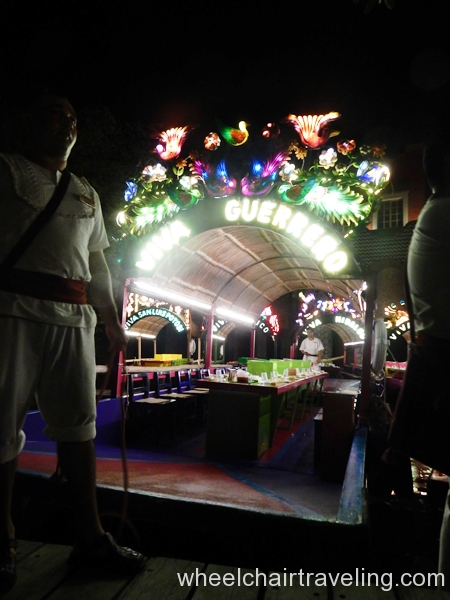
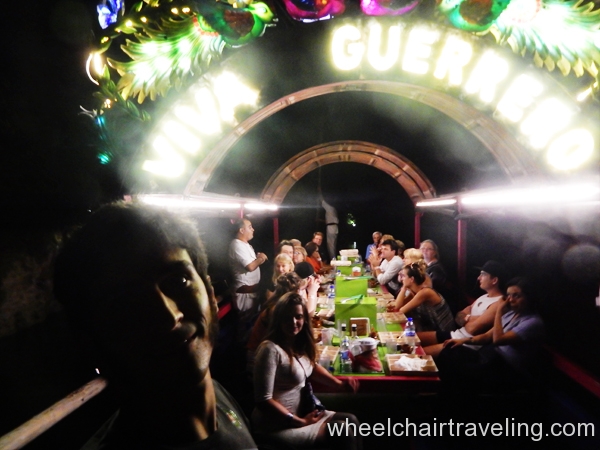
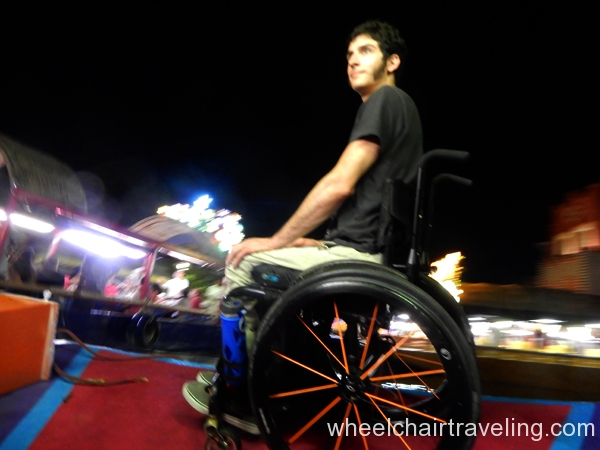
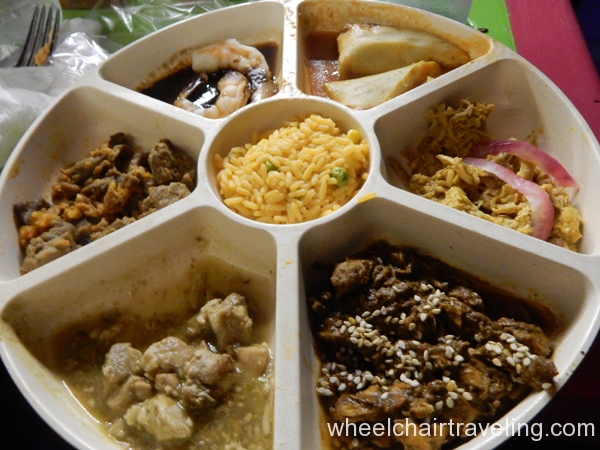
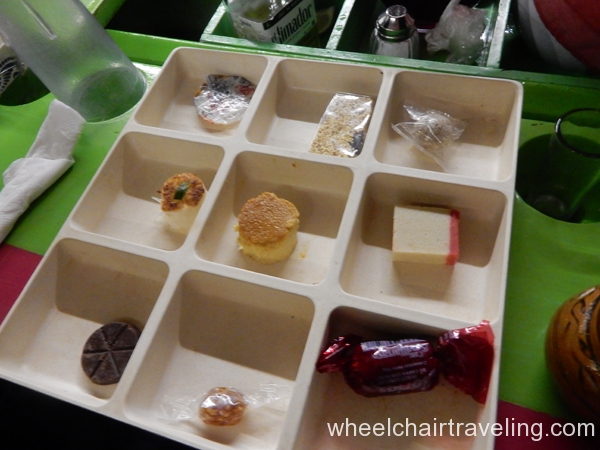
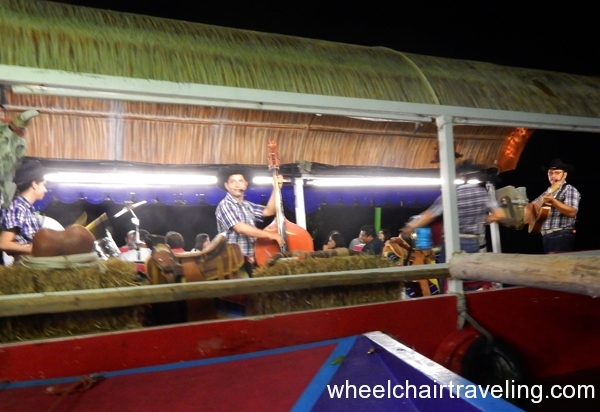
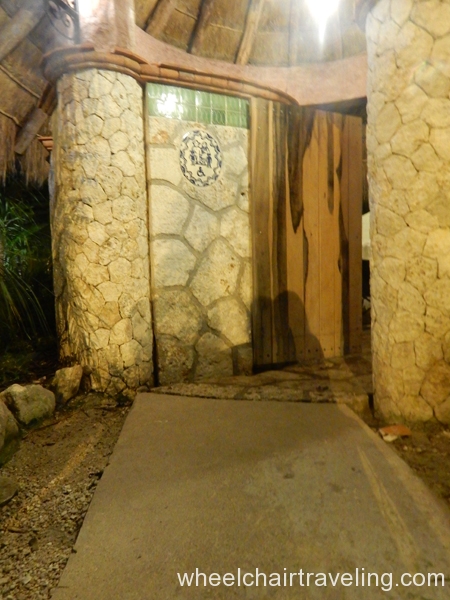
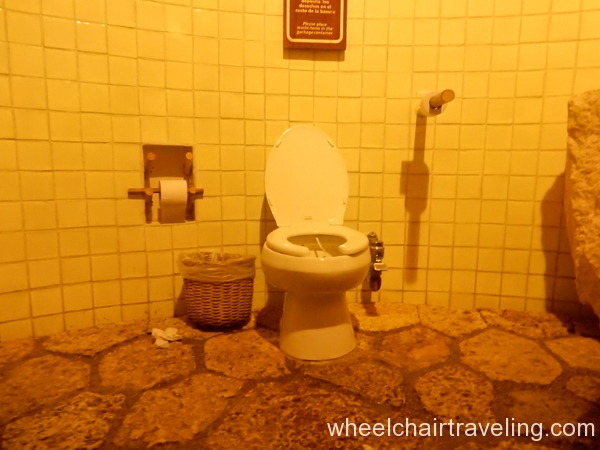
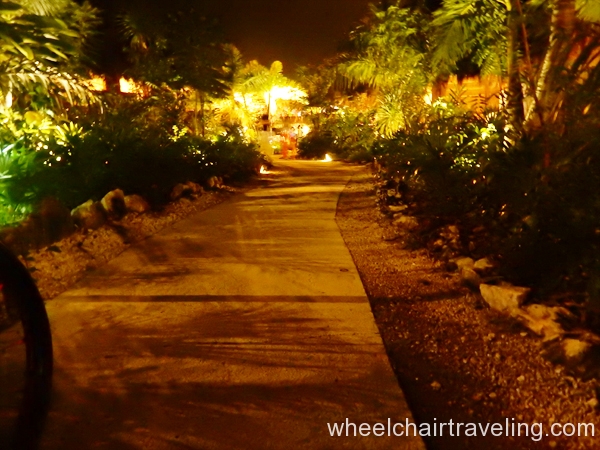
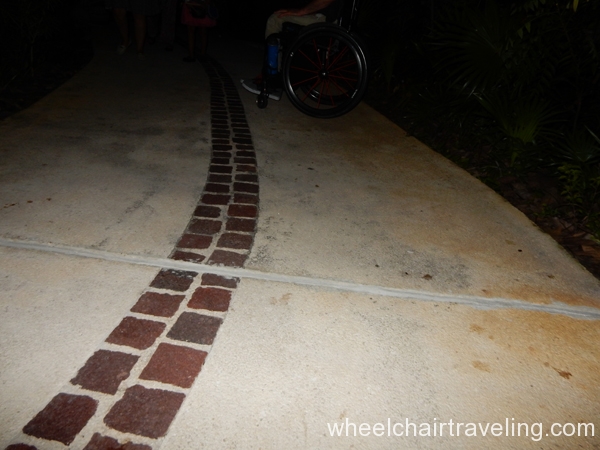
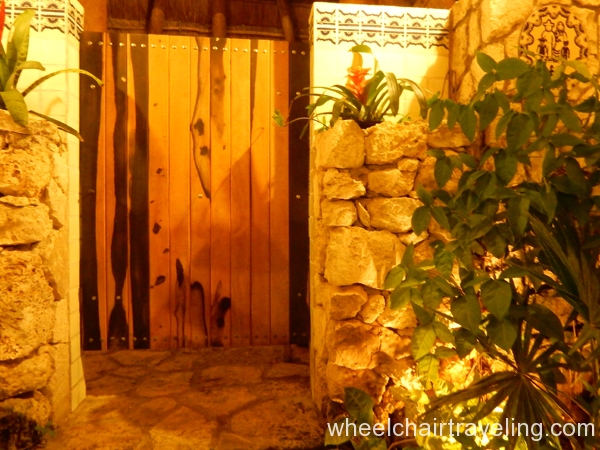
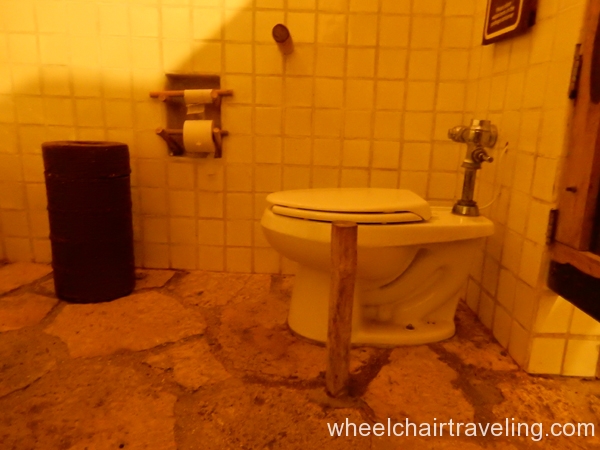
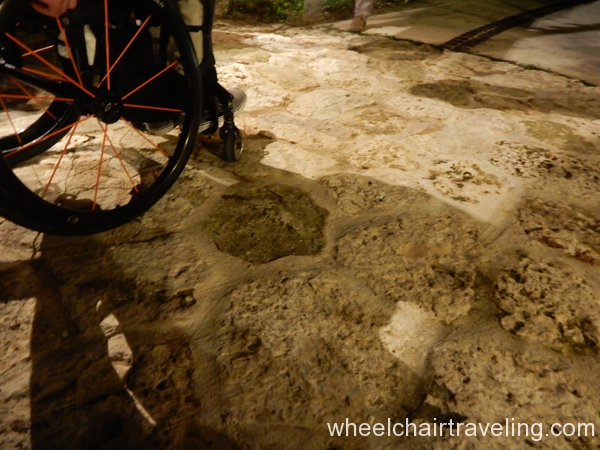

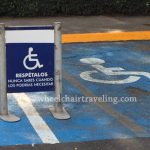
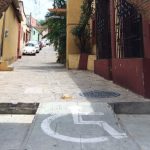
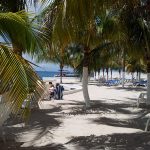
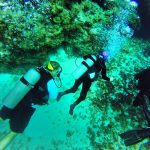



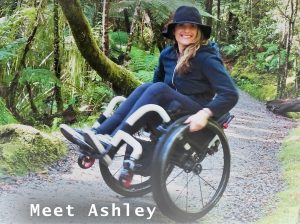

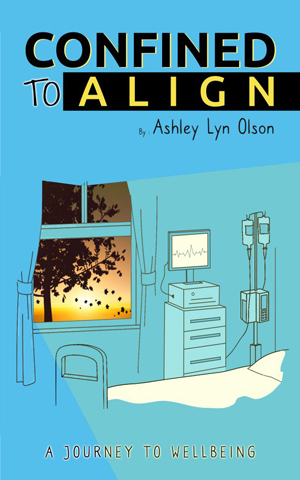
Thank you for this page! Both my mother and sister are in wheelchairs. We will be going to Isla Mujeres in June. Have you been there? Do you have any tips of accessible restaurants or if there is a beach wheelchair available to rent on the island?